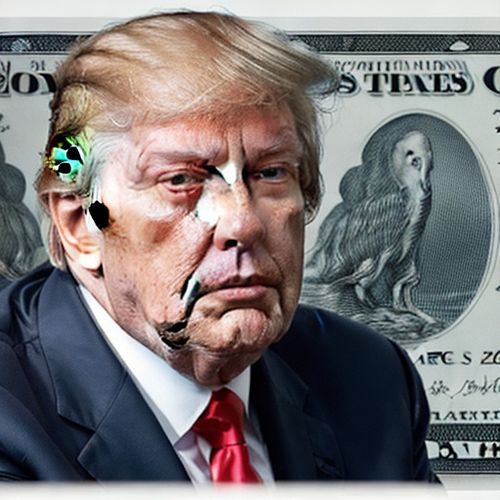In the intricate tapestry of the American economy, consumer sentiment is the delicate thread that holds the fabric together. It is a reflection of the hopes, fears, and expectations of the nation's shoppers, investors, and workers. Recently, however, this thread has been frayed by the winds of uncertainty, largely due to the unpredictable trade policies of President Donald Trump. Despite a temporary pause in the tariff hikes, the collective dread of a recession and rising inflation continues to cast a long shadow over the economic landscape.
The University of Michigan's latest survey, released in April, painted a stark picture: Consumer sentiment plunged by 8% from the previous month, settling at a final reading of 52.2. This decline, though slightly less severe than the preliminary reading, still marked the fourth-lowest level since records began in 1952. The survey's director, Joanne Hsu, noted that this month's deterioration was particularly pronounced among middle-income families, but the gloom spread across all demographics—age, education, income, and political affiliation alike. Consumers, it seems, are perceiving risks to multiple aspects of the economy, largely due to the ongoing uncertainty surrounding trade policy and the specter of inflation.
The stock market, ever-sensitive to shifts in consumer sentiment, reacted with a brief rally as investors digested the latest survey results. The Dow Jones Industrial Average was down 200 points, or 0.5%, while the S&P 500 dipped 0.15% and the Nasdaq Composite gained a modest 0.1%. These fluctuations are mere ripples compared to the potential tidal wave that could follow if consumer sentiment continues to deteriorate.
Trump's trade war, with its unpredictable tariff hikes and retaliatory measures from other countries, has been a significant weight on American attitudes toward the economy. The Federal Reserve and Wall Street are now closely monitoring whether this shift in sentiment will translate into more cautious consumer spending—or even a complete pullback. Given that consumer spending drives the majority of the US economy, such a development could spell weaker economic growth or, worse, a recession.
The US consumer, it appears, is caught in a state of unease. Yet, history has shown that sentiment does not always align perfectly with spending behavior. In June 2022, when inflation hit a four-decade high, consumer sentiment reached a record low. Despite the pessimism, shoppers continued to spend in the following months. Similarly, in 2023, a standoff in Congress over the debt ceiling soured Americans' economic mood, but they still splurged on travel and concerts. Both years saw solid economic growth and a robust labor market. As Fed Chair Jerome Powell remarked earlier this month, "Sometimes the surveys are very negative, but they keep spending."
However, today's economic landscape is markedly different from that of 2022. The job market is no longer booming at the same pace, and consumers have exhausted the savings they accumulated during the pandemic. Just this week, the Department of Education announced it would resume collecting federal student loans in default, ending a pandemic-era pause that had lasted roughly five years. There is also evidence that consumers became more financially strained at the end of last year, according to the New York Fed's latest quarterly survey on household finances.
Economists have struggled to assess the underlying health of consumer spending due to temporary distortions in economic data. For instance, the rush to purchase big-ticket items ahead of Trump's tariffs caused a surge in retail sales in March. But as long as unemployment remains low and layoffs do not accelerate significantly, spending should continue, albeit at a slower pace.
The lingering uncertainty over Trump's policies is also complicating the work of central bankers who set interest rate policy. These policies affect everything from mortgages to credit cards, making it crucial to understand the impact of tariffs on inflation. While Trump's tariffs are widely expected to boost inflation, economists debate the extent and duration of this effect. Minneapolis Fed President Neel Kashkari captured this dilemma when he said, "We just don't know right now with confidence: Is this a one-time effect on inflation, or is it something longer term? Our job with the Fed is to make sure it is not something longer term."
One critical measure that Fed policymakers are closely watching is people's perception of prices. These expectations can be self-fulfilling: If consumers anticipate higher and sustained inflation, they may adjust their spending accordingly. Inflation expectations for the year ahead, as reported in the University of Michigan's final consumer sentiment report for April, reached their highest level since 1981. For now, however, Fed officials have adopted a "wait-and-see" approach, observing how the US economy responds to the administration's significant policy changes.
Trump's "shock therapy," as it has been dubbed, has already made its mark on the so-called soft data—surveys like the University of Michigan consumer sentiment report. But there have been no red flags yet in the "hard data," which capture actual economic activity. Most Fed officials are keeping a close eye on any potential signs of economic fallout from Trump's policies, which extend beyond tariffs to include mass deportations and deregulation.
Fed Governor Adriana Kugler emphasized the importance of a comprehensive approach to understanding the economy: "It is important for monetary policymakers to broadly examine all available information, including market-based measures, surveys, and anecdotal reports, to understand what is happening in the economy as early as possible because, as I discussed, it takes time for policy to have an impact."
As the US economy navigates these turbulent waters, the role of consumer sentiment cannot be overstated. It is a barometer of the nation's economic health, reflecting the collective mood of its people. While the immediate impact of Trump's policies may be difficult to predict, the long-term consequences could be profound. The Federal Reserve, Wall Street, and policymakers must remain vigilant, ready to respond to any shifts in consumer behavior that could signal a turning point in the economic cycle.
The fate of the US economy may hinge on the delicate balance between consumer confidence and the uncertainties of the current policy environment. The challenge lies in steering the ship through these choppy waters without capsizing, ensuring that the thread of consumer sentiment remains strong enough to hold the economic fabric together.

By Eric Ward/Apr 29, 2025

By Jessica Lee/Apr 29, 2025

By Lily Simpson/Apr 29, 2025

By Amanda Phillips/Apr 29, 2025

By James Moore/Apr 29, 2025

By Amanda Phillips/Apr 29, 2025

By Sophia Lewis/Apr 29, 2025

By Ryan Martin/Apr 29, 2025

By Elizabeth Taylor/Apr 29, 2025

By Noah Bell/Apr 29, 2025

By Emily Johnson/Apr 29, 2025

By Grace Cox/Apr 29, 2025

By Rebecca Stewart/Apr 29, 2025

By Elizabeth Taylor/Apr 29, 2025

By Michael Brown/Apr 29, 2025

By Olivia Reed/Apr 29, 2025

By Daniel Scott/Apr 29, 2025

By Joshua Howard/Apr 29, 2025

By Megan Clark/Apr 29, 2025

By John Smith/Apr 29, 2025